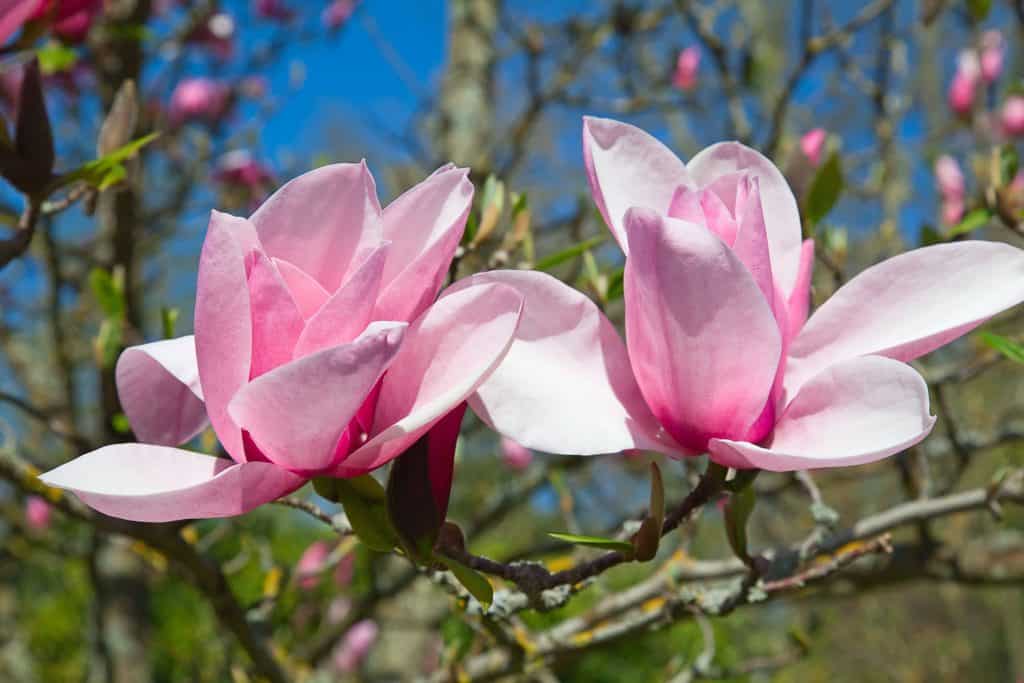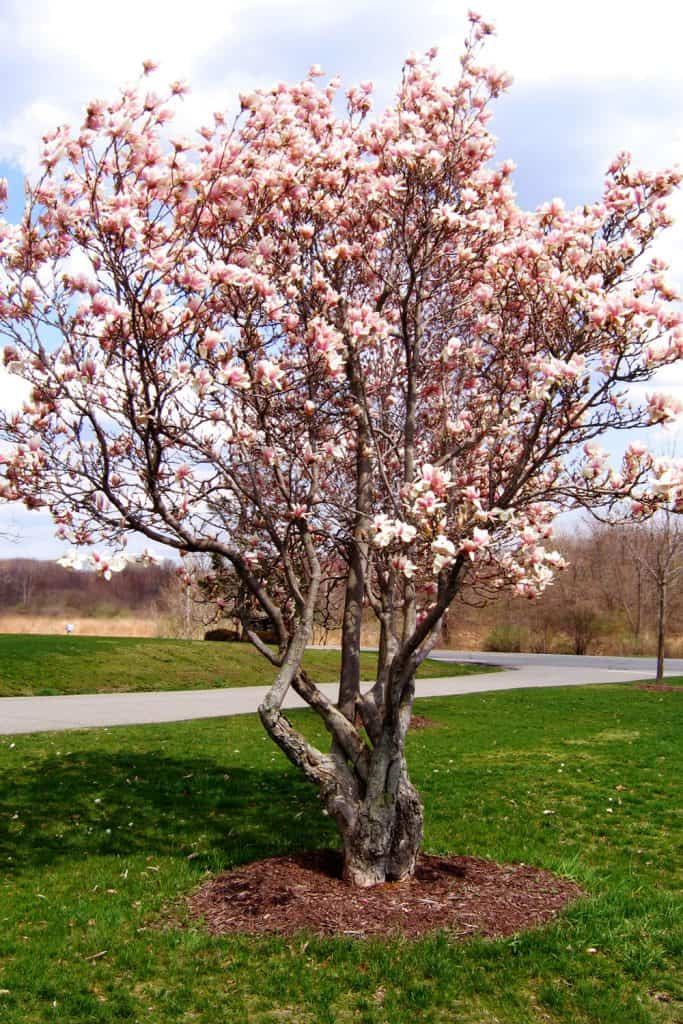The magnolia tree is known for its large fragrant flowers and beautiful leaves. Its dark green leaves are oval-shaped and coated with a waxy layer of fatty acid which helps the tree to retain water and repel pollutants. One question new gardeners often pose before purchasing magnolia trees is whether or not they will drop their leaves in the wintertime. We've checked with what gardeners have to say about this.
Many magnolia species are deciduous, which means that they will lose their leaves in the winter months of the year. Evergreen magnolia trees maintain their leaves during this time of the year. In fact, they will keep most of their leaves (but not all of them) all year round.
There are over 16 recognized magnolia tree species that exist in the US. These varieties vary in terms of the type of maintenance and care that they require. However, some commonly held care tips apply to magnolias in general. Continue reading to learn more about why some magnolias lose their leaves and how to care for these trees.

Why Magnolia Trees Lose Their Leaves In Winter

Most deciduous trees lose their leaves during the fall/winter season, and the deciduous magnolia tree is no exception. Their leaves fall off during the season to help the tree survive through the winter. Trees lose a lot of their water in the fall and winter months of the year. So when the trees shed leaves during the winter, the main reason is to simply conserve energy and water.
The Effects Of Cold Weather
As cold weather approaches, the magnolia tree's hormones initiate a process to absorb all of the moisture from the leaves and retains it within the branches and the trunk of the tree. During this process, all of the nutrients are absorbed from the leaves causing them to lose chlorophyll. As a result, they lose their green color--which is why the leaves turn yellow, red, and orange during the fall season.
Magnolia trees need a lot of energy to flower in the spring months, which is one of the biggest reasons why they drop so many leaves during the winter. If you notice that your magnolia tree is dropping a bunch of leaves at once, you needn't be concerned, magnolia trees will produce new leaves once the flowering process has been completed.
However, if all or most of the leaves drop, then you may want to ensure that the health of the tree is sufficient. It wouldn't be a bad idea to add a bit of mulch to the tree's soil (you can also use pine bark or pine straw) to prevent the soil from becoming compacted during this time. If the soil of the magnolia tree is compacted, it will hinder the accessibility of oxygen to the roots, causing serious problems for the tree. Applying mulch can also help to keep the weed population at a minimum.
Click here to see this mulch on Amazon.
How Do You Keep A Magnolia Tree Healthy?
There are a few important factors to consider when caring for a magnolia tree. They include giving it a sufficient amount of sunlight, ensuring proper watering, providing optimal soil conditions, and keeping the tree stress-free. It's also important to use fertilizer sparingly. Let's discuss each of these factors in more detail.
Sunlight
If you are planning to grow a magnolia tree in your garden, be sure to place it in an area where it has access to full sunlight and light shade. The evening shade can help to protect the tree from the hot afternoon sun.
Watering
It's important not to overwater your magnolia tree, as wet or soggy soil can become problematic. They generally prefer moist soil, though some varieties can withstand droughts longer than others.
A quick tip: If you are using an automated irrigation system to water your magnolia tree, it's best to set your timer for the early morning hours as opposed to evening or nighttime hours. Doing so can help to prevent the onset of fungus growth, root rot, and other plant diseases. After first planting a new magnolia tree, be sure to check the soil moisture level often to adjust the irrigation so that it doesn't overwater or underwater the tree.
Click here to see this irrigation kit on Amazon.
Soil Conditions
Most magnolia varieties prefer porous well-draining soil that has a pH of anywhere from 5 to 6.5. They require regular watering, though some varieties can tolerate dryness more than others. However, many magnolia trees can experience premature leaf drop during extreme drought.
Keep The Magnolia Tree Stress-Free
In general, magnolias prefer moist soil with a bit of mulch incorporated within it. Be sure to keep your tree's soil moist during the summer months or any dry spells during the year. If the tree becomes stressed out from underwatering, you will know it, as the leaves will begin to turn yellow and wither--and in extreme cases, they will drop.
You can always do the "finger test" to ensure that your tree's soil is moist and is providing the tree with the water that it needs to thrive. If you stick your finger in the soil and it's moist, then the tree is good to go. The soil should never feel dry and crumbly.
Applying Fertilizer
It's best to fertilize your deciduous magnolia tree during the late months of the fall once the leaves have dropped for the year. If your magnolia tree is an evergreen variety, it's best to fertilize it before outdoor temperatures drop below 40 degrees Fahrenheit. You can also fertilize the tree in the early spring before the new growing season.
Be careful when applying fertilizer since the sensitive roots of a magnolia tree can easily become burned, particularly from salt-based fertilizers. Common symptoms of fertilizer "leaf burn" are leaf edges that appear burnt and/or brown. If you damage your plant with the fertilizer, you will need to flush the roots completely using spring water and monitoring over the next few months. Magnolia trees generally won't require fertilizer unless they are growing slowly or are in a state of ill health.
Type of Fertilizer For Magnolia Trees
The type of fertilizer needed for a magnolia tree will depend on the variety, however, the most commonly used fertilizers have an NPK (Nitrogen-Phosphorus-Potassium) ratio of 20-5-10 or 12-4-8. Nitrogen is typically the most important nutrient required by magnolia varieties. It's best to use a slow-release certified fertilizer for your magnolia tree so that it will continue to grow and produce healthy foliage.
Click here to see this fertilizer on Amazon.
How Many Times A Year Do Magnolia Trees Bloom?
It depends on the variety of magnolia in question. Some magnolia trees can bloom multiple times during the spring months of the year while others may only bloom once from winter to mid-summer. For example, Southern and Sweetbay Magnolias only bloom once during May and June while Star Magnolia trees bloom multiple times from March through the end of April.
If you are considering planting a new magnolia in your garden, it may be worthwhile to note the number of times a year the tree will bloom to prepare for leaf clean up.
Are Magnolia Trees Messy?

Some magnolia varieties are known to be rather messy due to their cone and leaf dropping. Most magnolia trees that grow cones tend to drop them every season while some varieties will drop them multiple times in one season. The latter can make for a pretty cumbersome cleanup.
In addition to the cones, varieties that bloom multiple times a year will also shed leaves more than once each year, thus creating even more foliage to clean up. Depending on the size of your tree, it can shed anywhere from 100 to 200 cones per growing season.
If you are considering planting a magnolia tree around your home and are concerned about leaf and cone clean up, be sure to do your due diligence to determine the blooming pattern of your magnolia.
Do Magnolia Leaves Grow Back?
After a magnolia tree has shed its leaves for the blooming season, they will eventually grow back. They usually grow back during the spring when the tree starts to bloom again.
If your tree's leaves aren't growing back, this is a tell-tale sign that it is experiencing a high state of stress and needs a little TLC. Also, if you notice that the leaves on your tree start to grow smaller and smaller over the years, this could be a sign that your tree is suffering from a serious health issue.
Wrapping Things Up
To sum things up, deciduous magnolia trees will lose their leaves in the fall season while evergreens will not. A magnolia tree can be the perfect addition to your garden if you are new to gardening or prefer trees that require little maintenance. These trees rarely suffer from common plant diseases or issues with pests, and they don't require any pruning to grow and thrive.
But before you go, be sure to check out our other posts:



